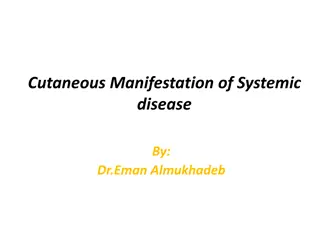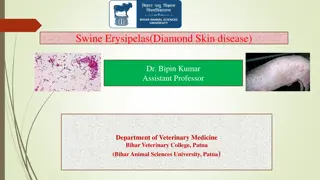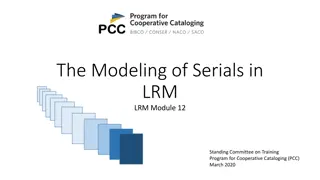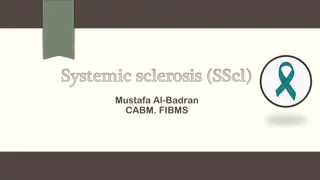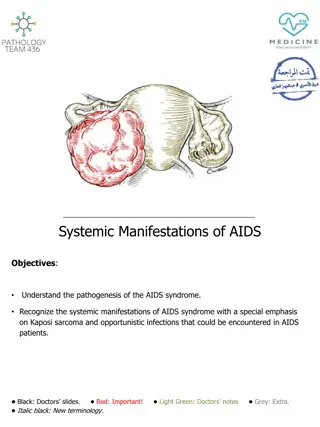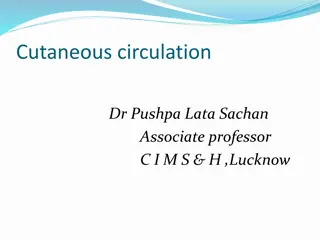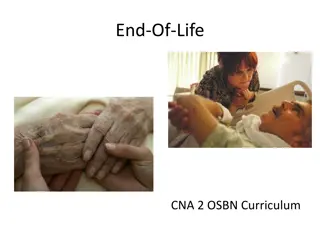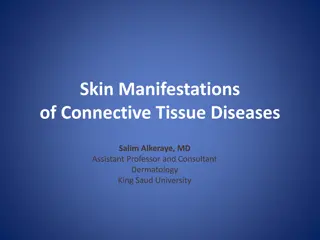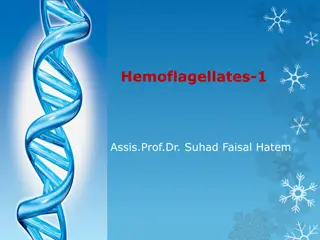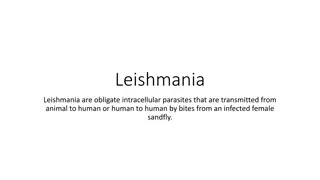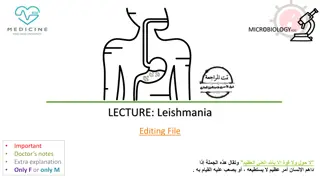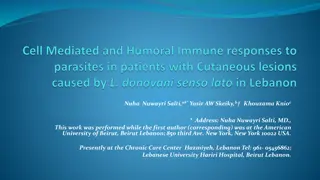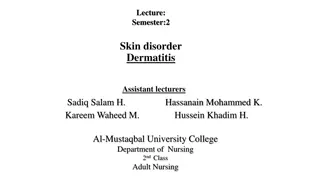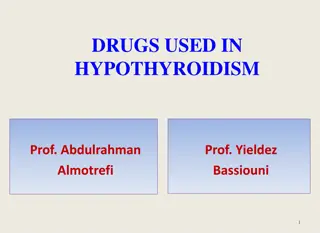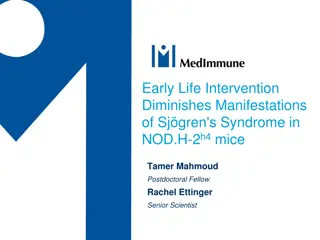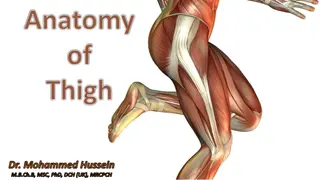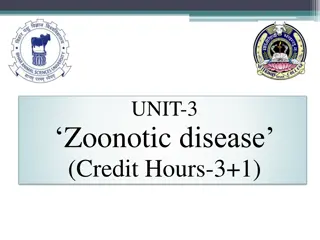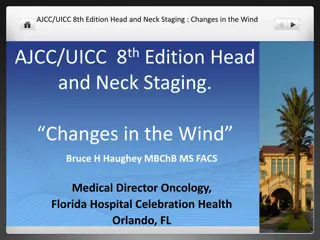Dermatologic manifestations of diabetes mellitus.
The presentation slides discuss various dermatologic manifestations of diabetes mellitus, including acanthosis nigricans, diabetic dermopathy, acrochordons (skin tags), and necrobiosis lipoidica diabeticorum (NLD). Each feature description, location, mechanism, and treatment options are detailed alo
8 views • 10 slides
Overview of Superficial Fungal Infections of the Skin
Superficial fungal infections of the skin are categorized into superficial, cutaneous, and subcutaneous types. Superficial mycoses affect the stratum corneum and include conditions like tinea versicolor, tinea nigra, and piedra. Tinea versicolor is a chronic infection caused by Malassezia furfur, wh
3 views • 31 slides
Cutaneous Manifestations of Systemic Diseases: Endocrine Disorders and Diabetes Mellitus
Explore the cutaneous manifestations of systemic diseases, particularly focusing on endocrine disorders like diabetes mellitus. Learn about the dermatologic signs associated with conditions such as hypothyroidism, hyperthyroidism, Addison's disease, and Cushing syndrome. Discover specific manifestat
0 views • 88 slides
Understanding Swine Erysipelas: Causes, Symptoms, and Prevention
Swine Erysipelas, caused by Erysipelothrix rhusiopathiae, is a significant disease in pigs, characterized by cutaneous erythema, diamond-shaped lesions, septicemia, and arthritis. The infection is primarily transmitted through contaminated feed, water, or skin abrasions. Clinical findings include su
0 views • 11 slides
Understanding Cholestasis: Etiology, Clinical Manifestations, and Complications
Cholestasis is characterized by reduced bile flow and elevated direct bilirubin. It is critical to differentiate it from neonatal jaundice. In conditions like biliary atresia and 1-antitrypsin deficiency, early diagnosis and intervention are crucial to prevent liver failure. Clinical manifestations
5 views • 14 slides
Understanding Fungi Diversity and Infections in Microbiology
Explore the world of fungi and fungal infections in this foundation block of microbiology. Learn about medically important yeasts, mold fungi, major fungal diseases, antifungal agents, and infection acquisition methods. Dive into hypersensitivity reactions, mycotoxicoses, and various types of fungal
1 views • 19 slides
Modeling of Serials in IFLA LRM Module 12 by PCC
Serials in library cataloging are modeled as complex constructs in IFLA LRM with considerations for whole/part and aggregation relationships. This module explores the intricacies of serial manifestations, issue manifestations, and the concept of WEM lock, providing insights into collocating closely-
0 views • 15 slides
Understanding Repair by Connective Tissue in Healing Processes
Healing or repair by connective tissue occurs in response to severe or chronic tissue injuries, leading to the replacement of nonregenerated cells with connective tissue or scar formation. This process involves the induction of fibroblast and endothelial cell proliferation, granulation tissue format
2 views • 26 slides
Understanding Systemic Sclerosis: Causes, Symptoms, and Management
Systemic sclerosis (SScl) is an autoimmune disorder affecting connective tissue, leading to fibrosis in the skin, internal organs, and vasculature. It is characterized by Raynaud's phenomenon, digital ischemia, sclerodactyly, and cardiac, lung, gut, and renal involvement. Peak onset is in the fourth
1 views • 28 slides
Understanding Glanders: Causes, Symptoms, and Transmission
Glanders, also known as Farcy, Equinia, or Malleus, is a contagious disease affecting horses, mules, and donkeys. It is caused by the bacteria Pseudomonas mallei and can be transmitted through direct contact or inhalation. The disease manifests with nodules or ulcers in the respiratory tract and on
0 views • 11 slides
Understanding Rickettsia: Pathogenesis, Clinical Manifestations, and Diagnosis
Rickettsia, a genus of Gram-negative bacteria transmitted by arthropods, is responsible for diseases like Rocky Mountain spotted fever. It causes symptoms such as high fever, rash, and severe headache. Laboratory diagnosis involves serology and isolation from experimental animals. Learn more about R
1 views • 9 slides
Understanding Systemic Manifestations of AIDS
Human Immunodeficiency Virus (HIV) is a retrovirus causing Acquired Immunodeficiency Syndrome (AIDS). HIV leads to immune system destruction, making individuals vulnerable to opportunistic infections and tumors. Common sexually transmitted diseases like syphilis, chlamydia, and gonorrhea are discuss
6 views • 15 slides
Understanding Cutaneous Circulation and Blood Supply in Different Body Regions
Cutaneous circulation plays a vital role in supplying blood to the skin, with variations in apical and non-apical regions of the body. The blood flow is regulated by neural, thermal, and metabolic factors, and controlled by sympathetic fibers. Sympathetic vasoconstriction and vasodilation affect the
0 views • 19 slides
Overview of Cutaneous Tuberculosis: Causes, Classification, and Clinical Features
Cutaneous tuberculosis is caused by Mycobacterium tuberculosis and its manifestations depend on the host's immunity, route of entry, and bacterial load. It is classified into exogeneous and endogenous sources, with various types such as tuberculides and tuberculous chancre. Clinical features include
0 views • 31 slides
Oral Manifestations of Systemic Diseases in Dentistry
This content explores various systemic diseases and their oral manifestations relevant to dentistry. It covers associations between heart disease and periodontal disease, effects of chronic corticosteroid use on the pulmonary system, endocrine disorders like diabetes and thyroid issues, autoimmune d
1 views • 63 slides
End-of-Life Care: Understanding Physical Manifestations and System Responses
End-of-life care focuses on addressing the physical and psychosocial needs of individuals and their families during the dying process. It aims to provide comfort, supportive care, and improve the quality of life in the remaining days. Death occurs when vital organs cease to function, and specific ph
0 views • 15 slides
Understanding Cellular Injury and Its Manifestations
Cellular injury can occur due to various factors like physical trauma, chemicals, radiation, and biologic agents. This process can lead to reversible or irreversible damage in cells, affecting their normal functions and possibly leading to cell death. Manifestations of cellular injury include cellul
0 views • 9 slides
Understanding Cutaneous Manifestations of HIV and AIDS
Human Immunodeficiency Virus (HIV) is a lentivirus that infects CD4 T lymphocytes, leading to Acquired Immunodeficiency Syndrome (AIDS). Cutaneous manifestations of HIV/AIDS vary depending on the stage of infection and CD4 T cell counts. Early signs include exanthem, oral hairy leukoplakia, candidia
0 views • 17 slides
Skin Manifestations of Connective Tissue Diseases - Lecture Highlights
This lecture series discusses the various skin manifestations of connective tissue diseases, focusing on Lupus Erythematosus and other related conditions. It covers different types of Lupus, its effects on the body systems, treatment options, and psychosocial impacts. Additionally, the presentation
0 views • 76 slides
Innovative Method for Portraying Cutaneous Diseases by Body Area Involvement Percentage
A unique approach utilizing a custom map creator to visually represent cutaneous diseases based on body area involvement percentage. The process involves manual tracing of body areas on custom maps created efficiently to provide a color-coordinated heatmap presentation. This method, developed at The
0 views • 6 slides
Understanding Upper and Lower Motor Neuron Lesions: Effects and Manifestations
This content delves into the intricacies of upper and lower motor neuron lesions, detailing their effects and manifestations in the human body. It explores the causes, types of paralysis, reflexes, muscle tone changes, and the impact of lesions at various levels of the motor system. The insights pro
0 views • 45 slides
A Comparison of Human and Frog Anatomy and Physiology
Humans and frogs share many similarities in their organ systems such as lungs, digestive, circulatory, skeletal, and muscular systems. However, there are also significant differences in body configuration, respiratory system, skeletal structure, and reproductive system. Frogs have unique features li
0 views • 7 slides
Understanding Hemoflagellates: Leishmania and Trypanosoma Species
Hemoflagellates are blood and tissue parasites belonging to the genera Leishmania spp. and Trypanosoma spp. This article discusses their life cycle, pathogenicity, diseases they cause like visceral and cutaneous leishmaniasis, and diagnostic methods. Special focus is given to Leishmania donovani and
0 views • 14 slides
Understanding Leishmaniasis: Transmission, Symptoms, and Epidemiology
Leishmaniasis, caused by obligate intracellular parasites transmitted through infected sandfly bites, has different forms including cutaneous, mucocutaneous, and visceral. The life cycle involves promastigote and amastigote stages. Epidemiologically, it is a zoonosis with natural reservoirs and can
0 views • 14 slides
Understanding Leishmaniasis: Types, Symptoms, and Treatment Options
Leishmaniasis is a parasitic disease caused by Leishmania parasites transmitted through infected sand flies. It comes in three forms - cutaneous, mucocutaneous, and visceral - each with distinct characteristics and treatment approaches. Cutaneous leishmaniasis causes skin ulcers, mucocutaneous affec
0 views • 32 slides
Understanding Leishmania: Parasites and Diseases Overview
Discover the three main forms of Leishmaniassis caused by different species, the clinical types of cutaneous leishmaniasis, and the life cycle of Leishmania parasites. Learn about the transmission, manifestations, and types of this disease, including cutaneous and visceral leishmaniasis.
0 views • 12 slides
Immune Responses to Leishmania Infections in Eastern Mediterranean Region
Dermal lesions caused by Leishmania donovani complex are rare in the Eastern Mediterranean region. Viscerotropic parasites can cause severe infections, while cutaneous infections are mainly caused by Leishmaniatropica and major complexes. Host immune reactions to different strains of Leishmania have
0 views • 30 slides
Clinical Manifestations and Complications of Neisseria Gonorrhoeae Infection
Neisseria gonorrhoeae, also known as gonococcus, is a bacterial pathogen responsible for gonorrhea. The virulence factors of N. gonorrhoeae include pili/fimbriae for adhesion, outer membrane proteins like Porin for protection, opacity-associated protein for adhesion to neutrophils, and more. Clinica
0 views • 15 slides
The Intricate Working of the Human Lungs Explained
The human lungs play a vital role in the efficient exchange of gases to provide oxygen for cellular growth and remove waste gases. Unlike some organisms that can use cutaneous respiration, humans rely on their lungs, which work in harmony with the cardiovascular system. Through a complex process inv
0 views • 11 slides
Understanding Dermatitis: Causes, Types, and Clinical Manifestations
Dermatitis is a common skin disorder characterized by inflammation, itching, redness, and skin lesions. This article explores the etiology, types (such as contact dermatitis and atopic dermatitis), and clinical manifestations of dermatitis, including acute and chronic phases. Learn about the risk fa
0 views • 17 slides
Drugs Used in Hypothyroidism and Their Effects
Hypothyroidism is characterized by an underactive thyroid gland, leading to a variety of symptoms. This detailed presentation covers the causes, manifestations, and treatments of hypothyroidism, with a focus on the drugs used for treatment. Learn about different classes of medications, their mechani
0 views • 20 slides
Exploring the Divine Creations and Manifestations
Delve into the intricate details of creation and manifestations according to ancient texts, understanding the diverse inhabitants and landscapes across the universe. Learn about the purposeful organization of different beings in various environments, guided by the profound laws of nature and the int
0 views • 55 slides
Early Life Intervention Diminishes Sjögren's Syndrome Manifestations in Mice
Early life intervention has been shown to reduce the clinical manifestations of Sjögren's syndrome in NOD.H-2h4 mice, which mimic key features of the human autoimmune disease. The syndrome is characterized by salivary gland autoantibodies, ectopic lymphoid follicles, reduced salivary and tear flow,
0 views • 19 slides
Comprehensive Overview of Thigh Anatomy by Dr. Mohammed Hussein M.B.Ch.B, MSC, PhD
Dr. Mohammed Hussein provides a detailed exploration of the anatomy of the thigh, covering regional anatomy, connections, compartments, and cutaneous nerves. The discussion delves into the front and medial aspects of the thigh, offering valuable insights for medical professionals and enthusiasts ali
0 views • 74 slides
Overview of Strongyloidea Parasites in Veterinary Parasitology
This informative text covers the morphology, life cycle, and common genera of Strongyloidea parasites, including Ancylostoma caninum and Bunostomum sp. It also discusses the occurrence of cutaneous larva migrans and details the Superfamily Trichostrongyloidea. Profound insights into practical parasi
0 views • 11 slides
Understanding Zoonotic Diseases and Mycoses
Zoonotic diseases, caused by fungi, have the potential to affect both animals and humans and are often transmitted through various environmental factors. These diseases can lead to a range of conditions affecting different organs and structures of the body. Mycoses, such as superficial and systemic
0 views • 19 slides
Multi-class Skin Lesion Segmentation for Cutaneous T-cell Lymphomas
This research focuses on developing a multi-class skin lesion segmentation method specifically for Cutaneous T-cell Lymphomas using high-resolution clinical images. The study introduces a new dataset, a novel method called Multi-Knowledge Learning Network (MKLN), and achieves state-of-the-art result
0 views • 15 slides
Understanding Purpura and Vasculitis: A Comprehensive Guide
Explore the differentiation between types of purpura, inflammatory and non-inflammatory distinctions, diagnosis of purpuric lesions, serious vs. non-serious conditions, causes of purpura, and an overview of vasculitis including its manifestations in large, medium, and small vessels with a focus on c
0 views • 24 slides
Understanding Papillomatosis (Warts) in Cattle
Papillomatosis, also known as warts, is a benign proliferative tumor affecting cutaneous and mucosal epithelia in cattle. It is caused by Papovavirus or Papillomvirus, with different subgroups affecting various body parts. The disease is self-limiting and primarily spreads through direct contact. Wh
0 views • 21 slides
AJCC/UICC 8th Edition Head and Neck Staging Changes
This content delves into the changes in staging guidelines for head and neck malignancies as per the 8th edition of the AJCC/UICC criteria. It explores the modifications in staging for oropharynx cancer, neck metastatic disease, oral cavity depth of invasion, and cutaneous malignancies. The presenta
0 views • 32 slides


